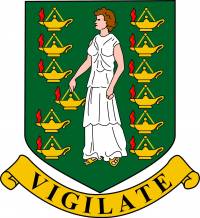The flag of the British Virgin Islands was adopted on November 15, 1960, and has a standard design for all British-controlled territories: the Union Jack (the flag of the United Kingdom of Great Britain and Northern Ireland) in the canton (upper left corner of the flag) on a blue background and the country's coat of arms on the right side of the flag.
Flag of British Virgin Islands







